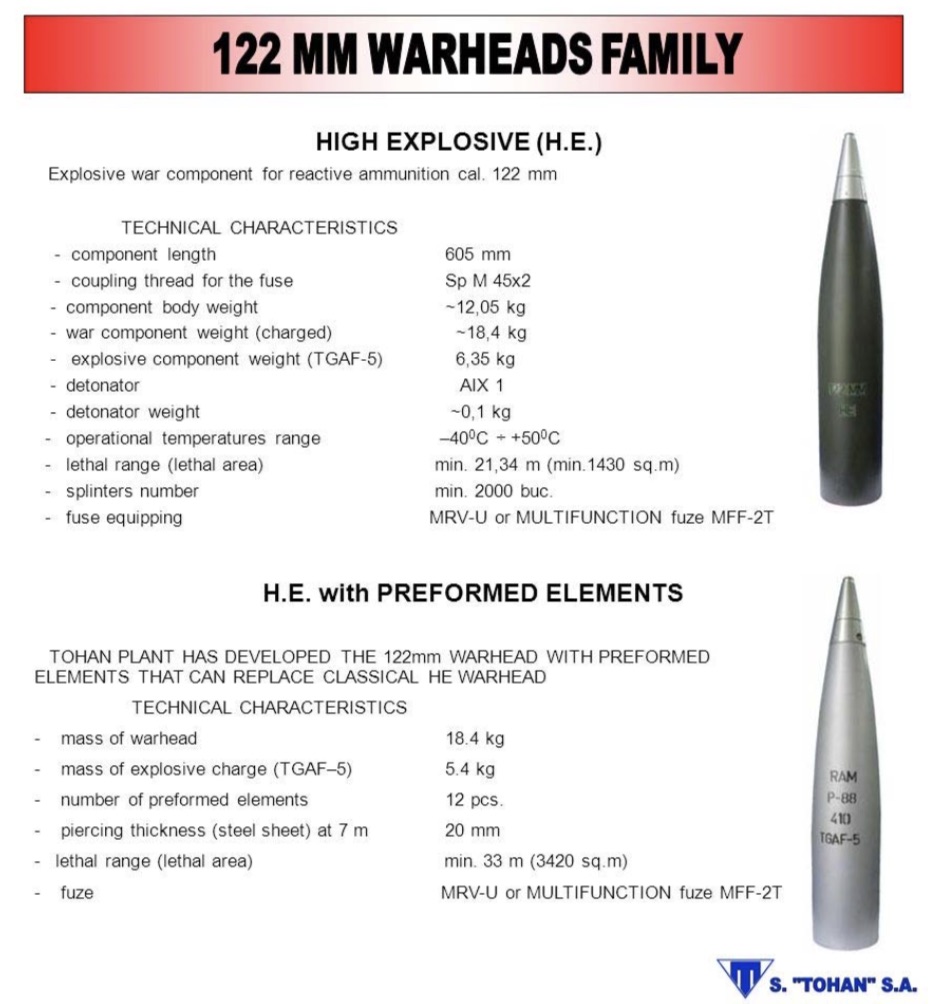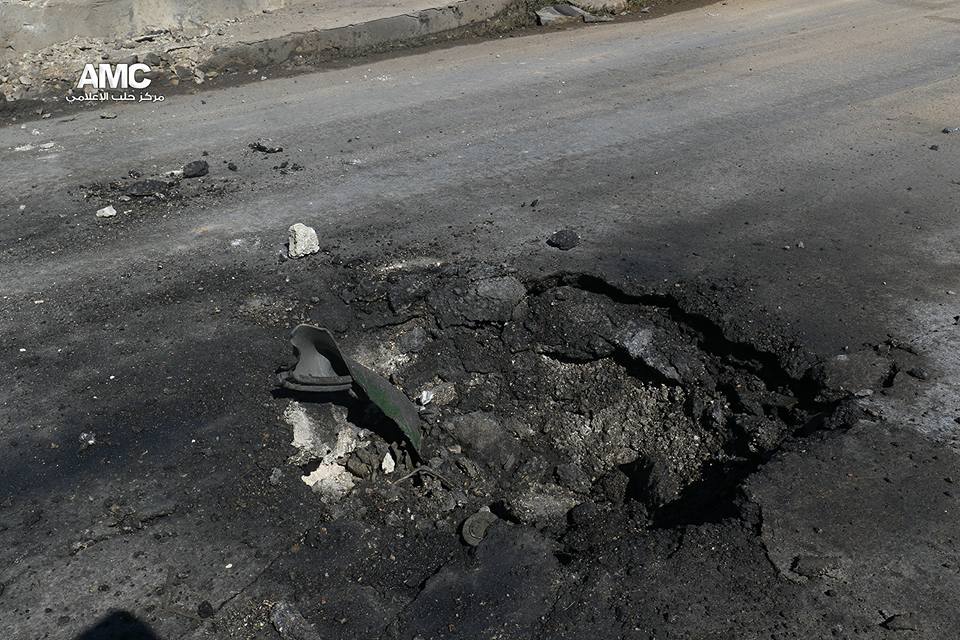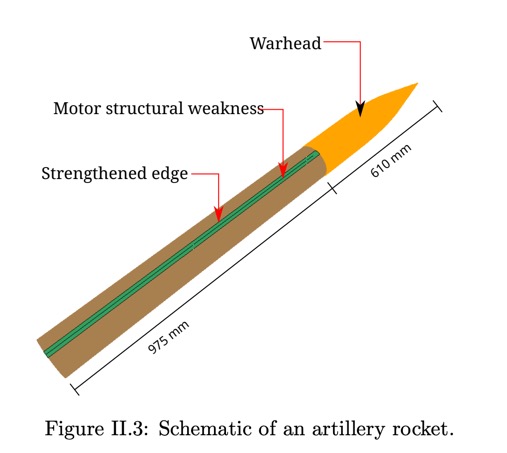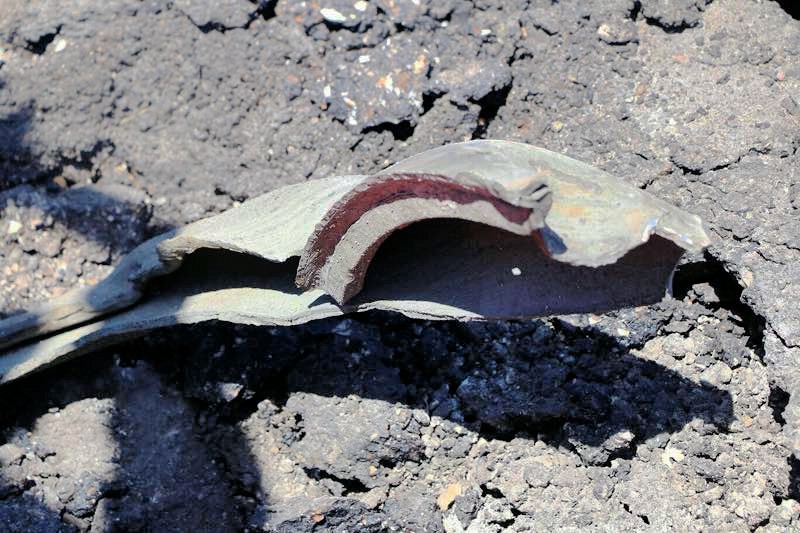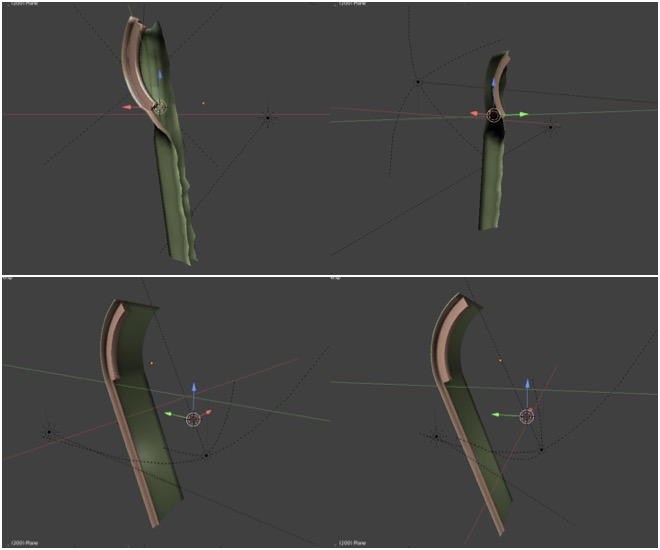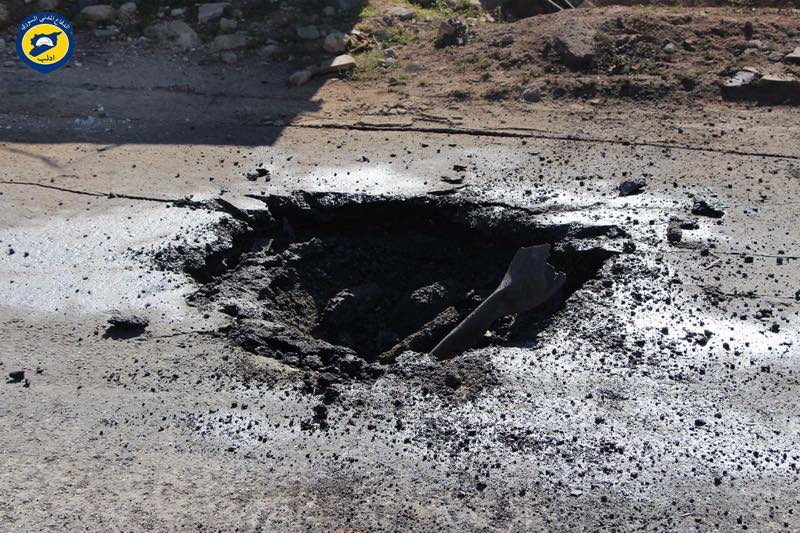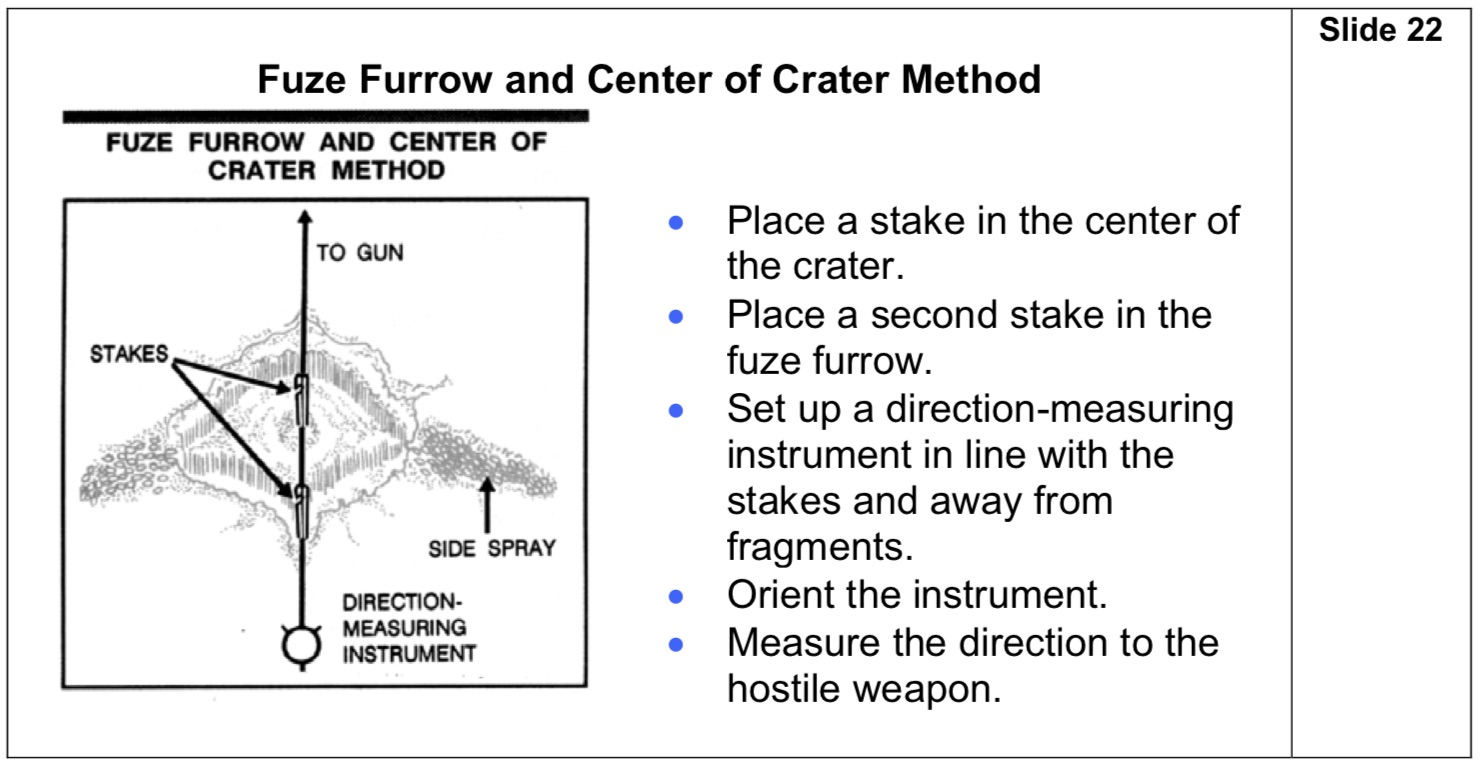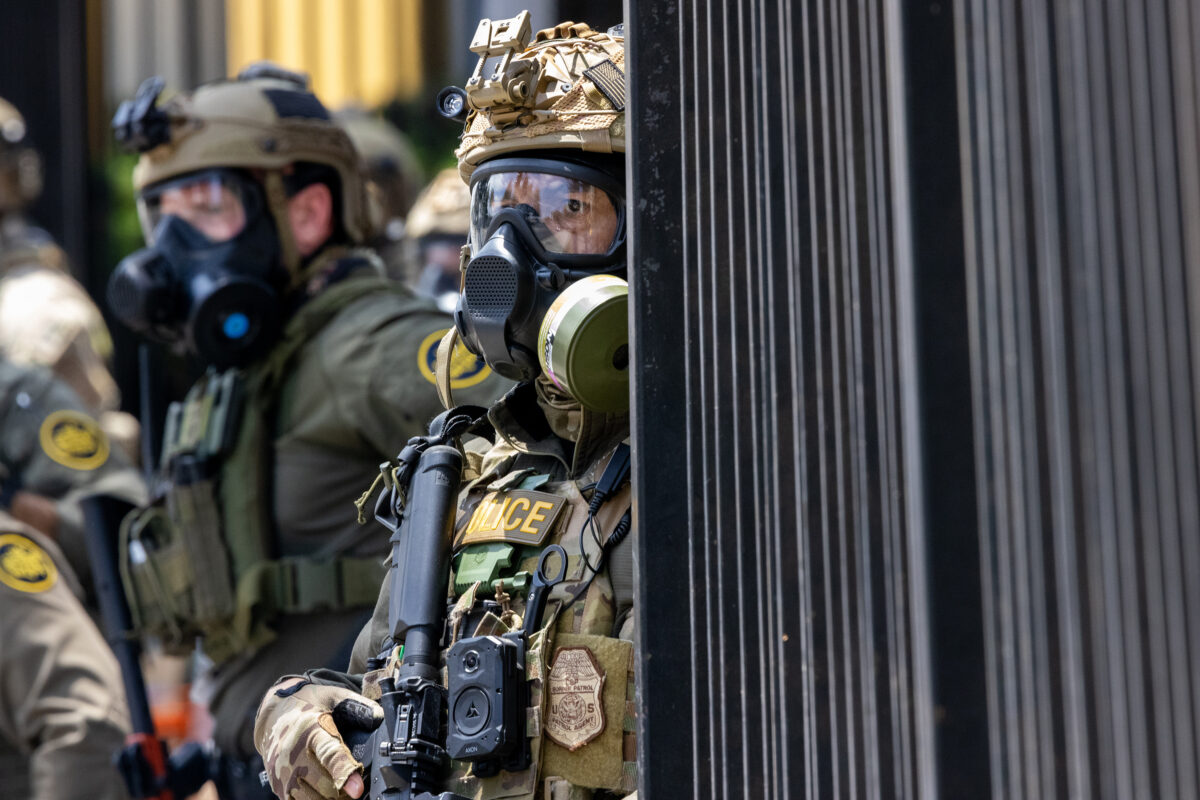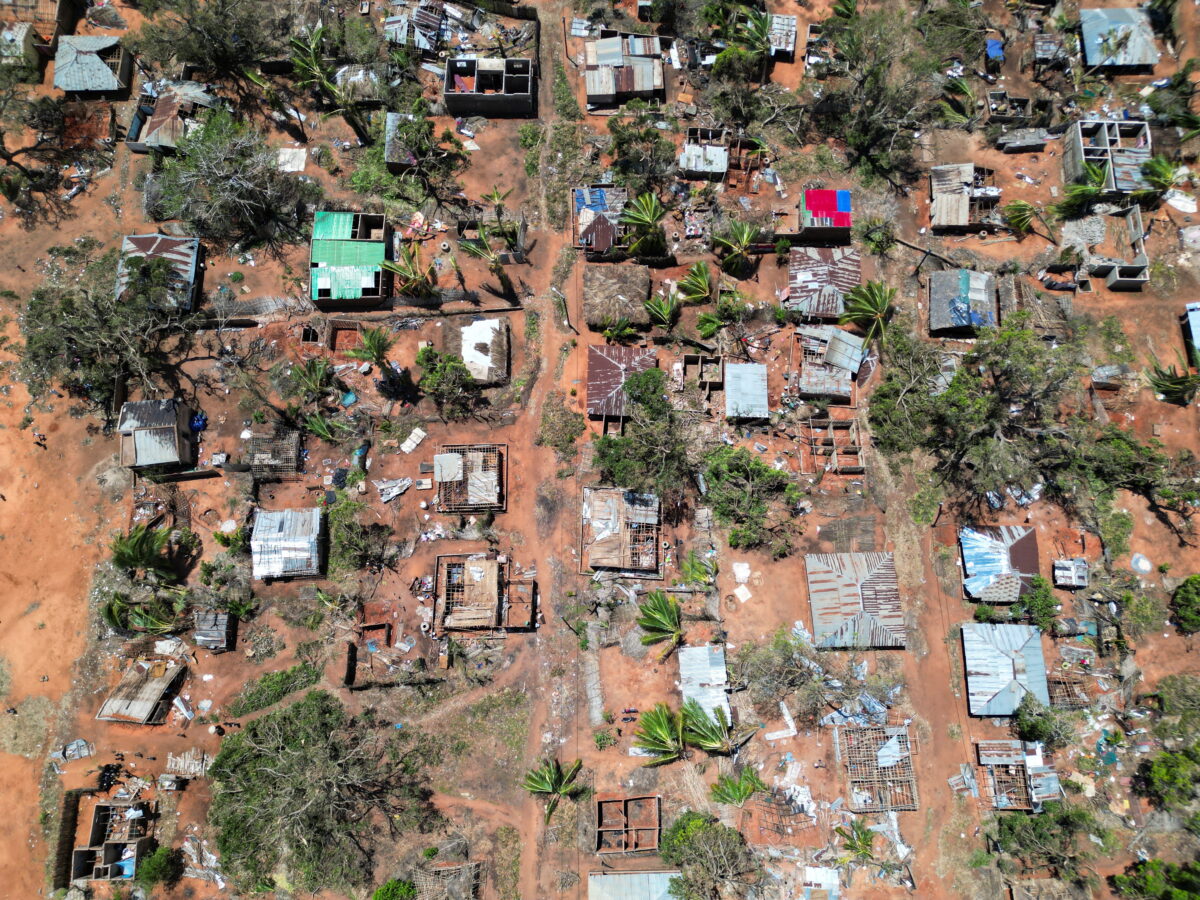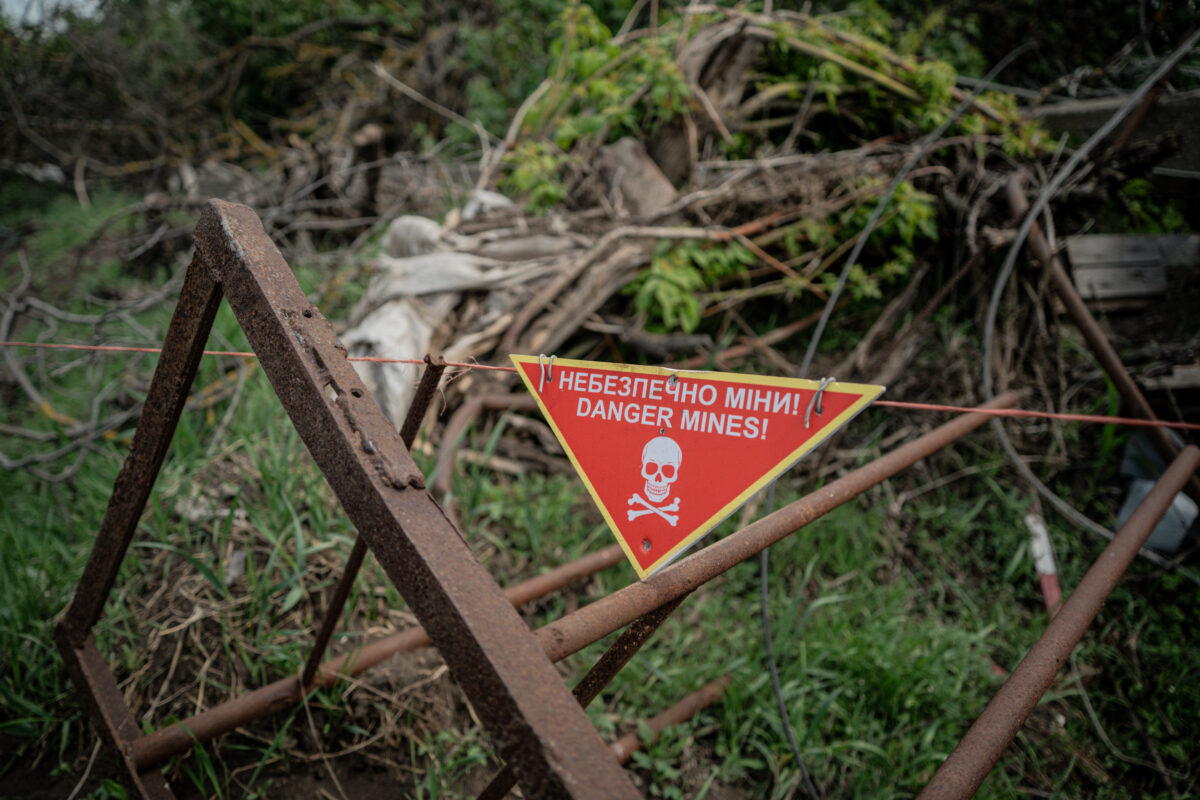Simulations, Craters and Lies: Postol’s Latest Attempt to Undermine the Last Vestiges of his Reputation
In the beginning of August 2019, the Tulsi Gabbard campaign published “Reports on Chemical Attacks in Syria”, expressing Gabbard’s views on the allegations of chemical weapons attacks in Syria — and based mainly on the work of Dr. Theodore Postol, Professor Emeritus of Science, Technology, and National Security Policy at the Massachusetts Institute of Technology (MIT).
Aside from various errors, contradictions, and misleading statements made on that page, links to the work of Postol on chemical weapons attacks in Syria were included. With this came what was believed to be a previously unpublished report, Computational Forensic Analysis for the Chemical Weapons Attack at Khan Sheikhoun on April 4, 2017, published by Postol and other contributors, that used computer simulations to make the allegation that the crater formed in Khan Sheikhoun was not formed by an air-dropped bomb as claimed by the OPCW-UN Joint Investigative Mechanism (JIM), but, in fact, by the impact of a 122 mm rocket impact.
Summary Of Postol & Co.’s Allegations
The main argument of Postol report focuses on the crater that the OPCW-UN Joint Investigation Mechanism report on Khan Sheikhoun stated “was caused by the impact of an aerial bomb travelling at high velocity”, specifically a chemical bomb. According to Postol et al’s report, computer simulations demonstrates this crater was in fact created by the impact of a surface to surface rocket.
In an October 25, 2017 letter discovered on The Russian Center for Policy Research (PIR Center) website, Postol describes the results of his report to a “Ms. Grebenkina”, requesting help with passing his “document on to the Russian delegation at the UN”. The PDF’s metadata states the original file name was “Note2Sputnik_(October25,2017)_” — meanwhile, a Sofya Grebenkina works for Russia’s Sputnik News.
On October 30, 2017, Sputnik published an article based on the contents of the letter, but did not include Postol’s request that the document is passed onto Russia’s UN delegation. It is unclear why the document is on the PIR Center website. Postol summarises his report as follows:
“Forensic computational analysis performed by two of my colleagues, Professor Goong Chen and Dr. Chung Gu, at Texas A&M University unambiguously explains how this crater was actually created.”
“Our calculations speculated that the crater was formed by a standard 122 mm artillery rocket explosive warhead of the kind that is ubiquitously available for purchase around the world. An example of this standardized warhead is shown in the image below. This particular variant of the warhead weighs about 18.4 kg and has a 6.35 kg explosive charge. The exact weight of the charge in these easily purchased warheads varies somewhat but the explosive effects of charges of slightly different weight is essentially irrelevant to the findings shown in our calculations.”
The image referred to by Postol is shown below. The original source of this image is a slideshow by Tohan SA, a Romainan arms manufacturer:
Postol then goes onto state, “Our results show exactly what is observed in the photograph.”
In his letter, Postol then moves on to the rocket motor used. Rather than being a standard 122 mm rocket motor, as used on rockets launched by the regular platform for launching 122 mm rocket — i.e. the BM-21 Grad multiple rocket launcher — i.e. Postol says the rocket was “almost certainly fabricated locally and a purchased warhead and igniter and nozzle assembly was attached to each end of the improvised rocket.”
Despite extensive imagery from the conflict in Syria documenting improvised weapons used by both sides in the conflict, Postol does not present a single example of an improvised rocket motor armed with a factory manufactured 122 mm warhead. The authors of this piece are also unaware of any existing examples of this.
Postol finishes the summary of his work thus:
“It is therefore unambiguous that the crater was created by a standard 122 mm explosive warhead of the type that can be purchased anywhere in the world. There is absolutely no evidence of any sarin containing vessel. The split pipe that has been inaccurately identified as evidence of the container filled with sarin is simply the casing of the rocket motor that propelled the purchased warhead to the location of the explosion.”
Comparison Of The Khan Sheikhoun Crater To 122 mm Warhead Impacts
Postol clearly states that the result of his investigation shows how a standard 122 mm explosive warhead formed the crater at Khan Sheikhoun, and that “the exact weight of the charge in these easily purchased warheads varies somewhat but the explosive effects of charges of slightly different weight is essentially irrelevant to the findings shown in our calculations.”
122 mm rockets are used widely in conflicts across the world. The craters formed by their impacts have been filmed and photographed. As Postol himself states the charges of different weights are “essentially irrelevant to the findings shown in our calculations” we can assume that if Postol et al’s calculations are accurate, then there should be many real world examples of craters formed by 122 mm warheads that are comparable to the crater seen in Khan Sheikhoun.
One particularly well documented instance of 122 mm rocket use is the January 2015 attack on Mariupol, Ukraine, where an urban center came under fire from multiple 122 mm rockets. The remains of rockets documented at the site indicate 122 mm rockets launched from BM-21 Grads were used, and these would carry the “standard” warheads Postol refers to. If Postol et al’s calculations are correct, we should expect to see craters on road surfaces that are a close match to the crater at Khan Sheikhoun.
However, this is clearly not the case when the Mariupol craters are compared to the Khan Sheikhoun crater. The Khan Sheikhoun crater is shown below:
Forensic Architecture was able to measure the crater, establishing it was 1.61 m wide at its widest point, and up to .49 m deep:
We can compare this to multiple craters on different surfaces in Mariupol. This graphic from Human Rights Watch show multiple craters, one of which shows the remains of a 122 mm rocket embedded in it, all of which are much smaller than the crater in Khan Sheikhoun:
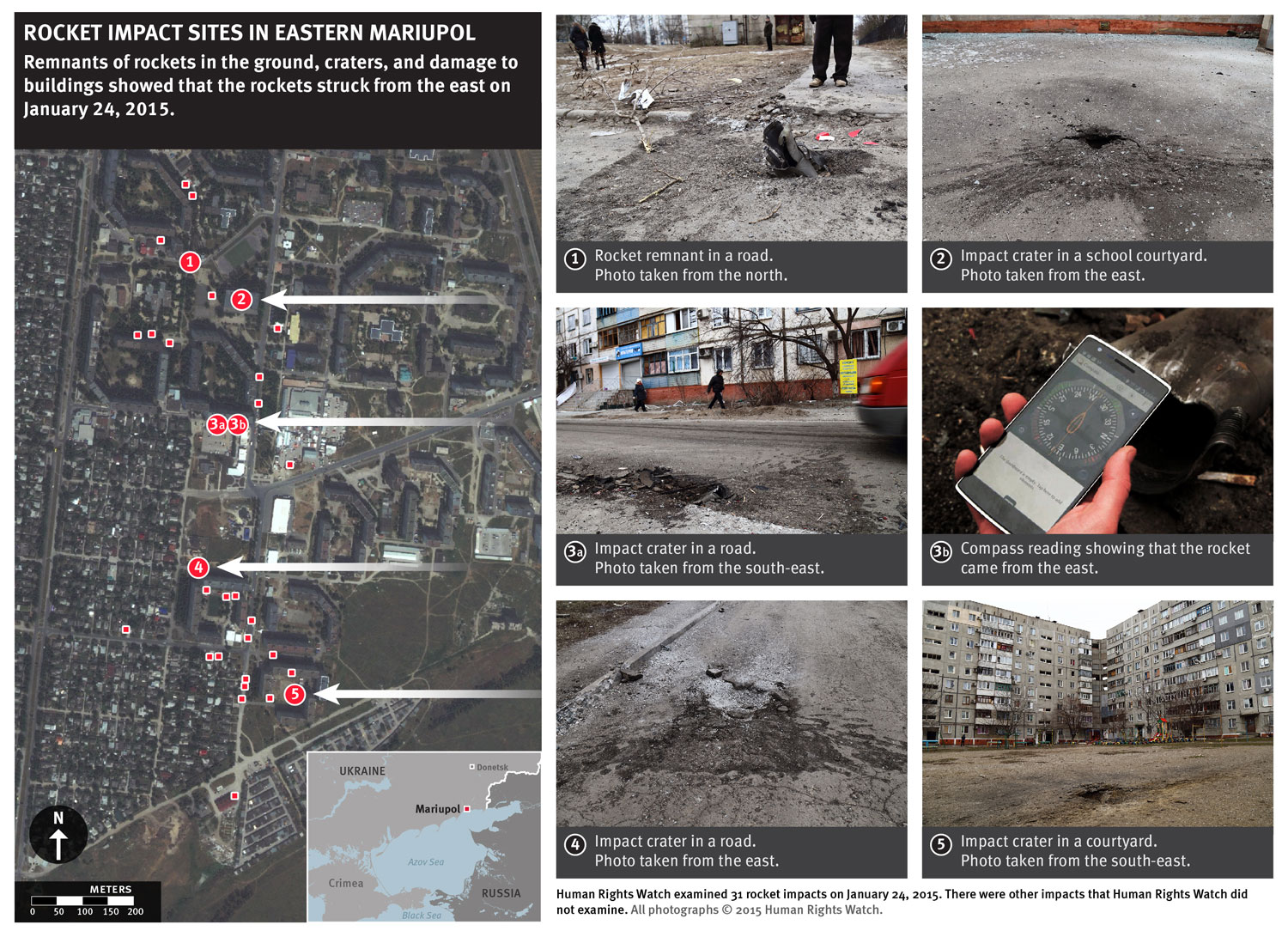
Human Rights Watch graphic showing 122 mm rocket craters after the January 2015 Mariupol attack (Source)
Bellingcat investigated the 2015 Mariupol attack and put together an extensive collection of videos showing the moment of the attack and the aftermath, with many 122 mm warhead impacts documented. None of these impacts look anywhere near to being the same as the crater at Khan Sheikhoun. Simply put, Postol et al’s claim that the crater at Khan Sheikhoun was created by a standard 122 mm warhead does not match real world evidence, regardless of what their simulation shows.
It is even possible to find 122 mm rocket craters in Postol’s own work, and they — surprise! — do not match the Khan Sheikhoun crater. In Postol’s “An Explanation of the Evidence of Weaknesses in the Iron Dome Defense System” he uses a number of images to explain his conclusions. Figure 16, titled “A rocket exploded near a road in the Sdot Negev Regional Council, causing damage to the road but no injuries. (July 2014)”, shows the remains of a rocket motor next to a small, shallow impact crater.
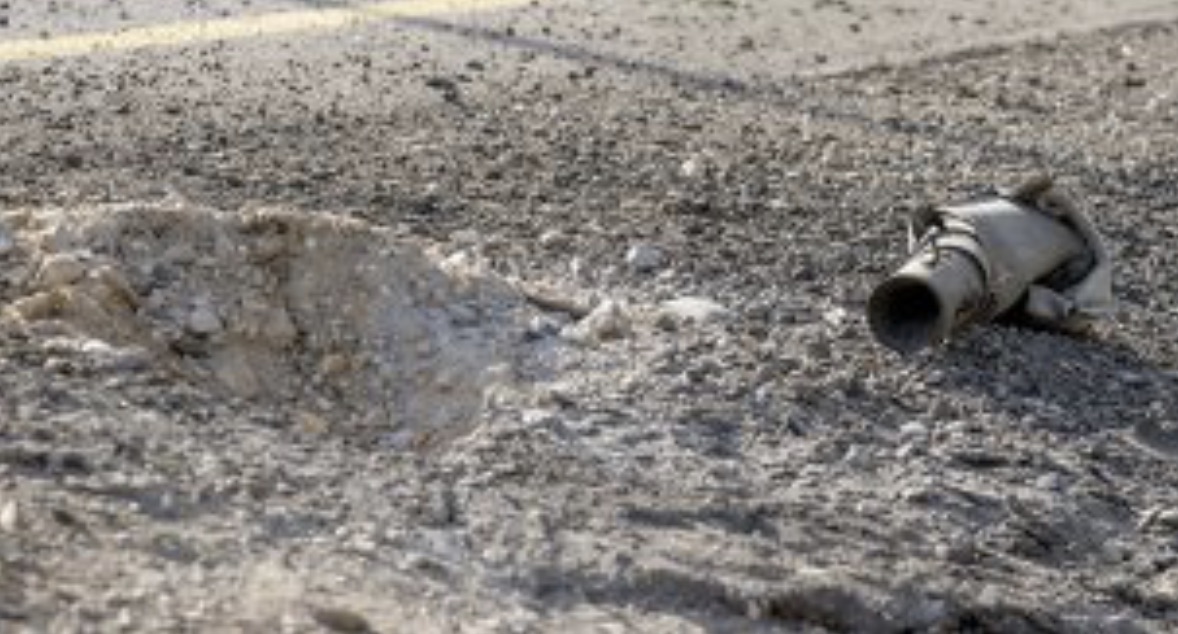
Figure 16 from Postol’s “An Explanation of the Evidence of Weaknesses in the Iron Dome Defense System” (Source)
A clearer image of the rocket motor can be seen here, while a close up of the motor is seen here. This is the rocket motor of a 122 mm rocket, used widely by Gaza based armed groups, and it would be armed with a “standard” 122 mm warhead. It is unclear how, despite Postol’s extensive work on the Iron Dome system and the rockets it intercepted, including 122 mm rockets, he was unable to see the significant discrepancies between his simulation and real world examples of 122 mm warhead impacts.
Comparison Of The Khan Sheikhoun Crater And The Postol Et Al Simulation
The Postol et al report relies heavily on claims that the remains of the munition inside the crater belong to an improvised 122 mm rocket, with manufacturing defects and with a “standard” 122 mm warhead. There is no reason stated for this measurement being selected, beyond the statement that it fits the simulation. The simulation includes the moment of impact, with the remains of the rocket motor coming to rest in the crater, as shown below:
There are two major discrepancies between this simulation and the actual crater documented at Khan Sheikhoun.
The remains documented inside the crater do not match the simulation results. Postol et al state that this debris is the remains of an improvised rocket motor, and that this cylindrical rocket motor split due to poor quality manufacturing. According to the simulation, the front end of the rocket motor splits as a result of the warhead detonation, as shown below.
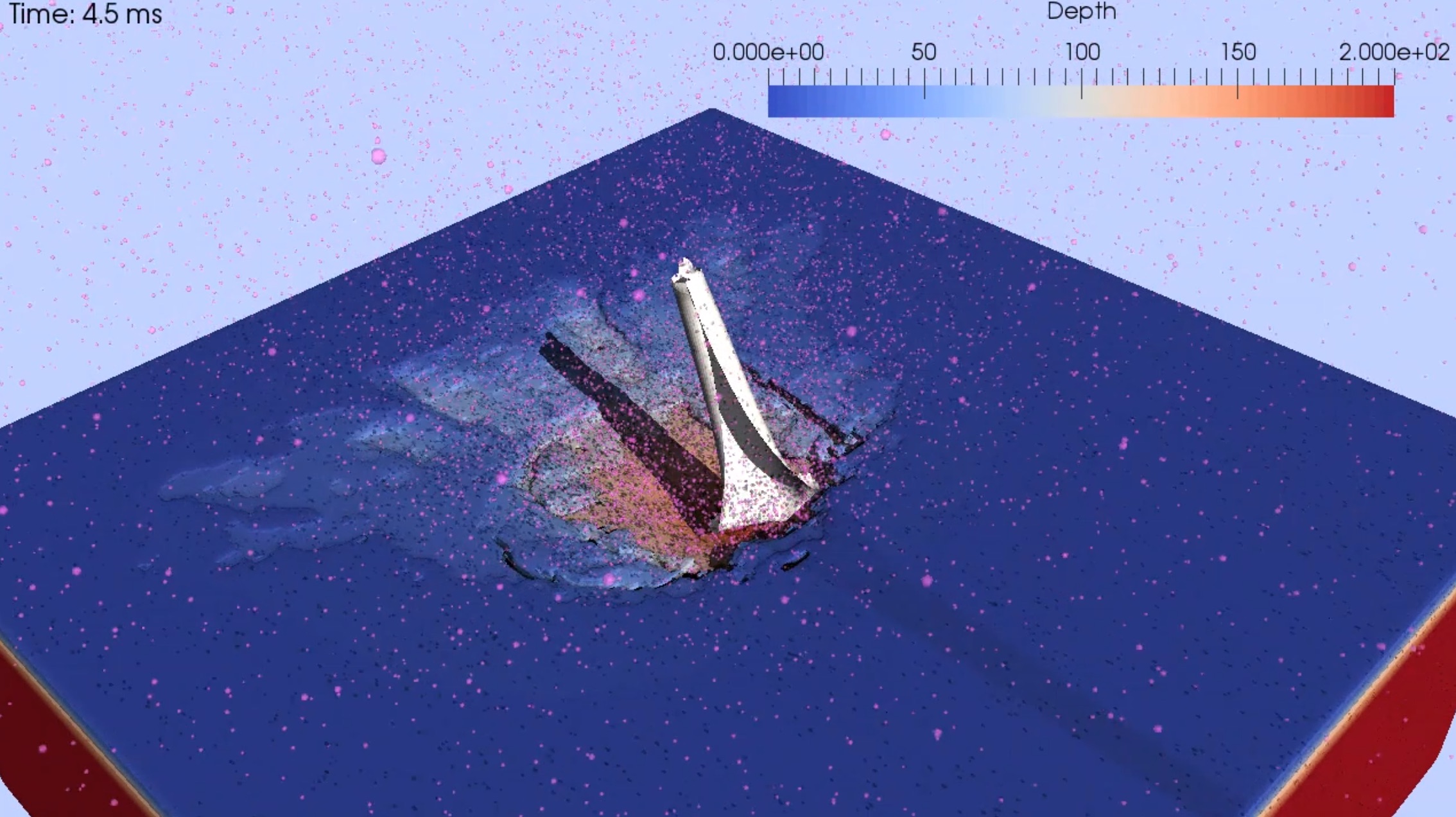
Screenshot from Postol et al’s simulation of the detonation of the simulated munition shortly after the warhead detonates (Source)
After the rocket comes to rest, the split section of the rocket is embedded in the crater, with the cylindrical rear of the rocket still visible:
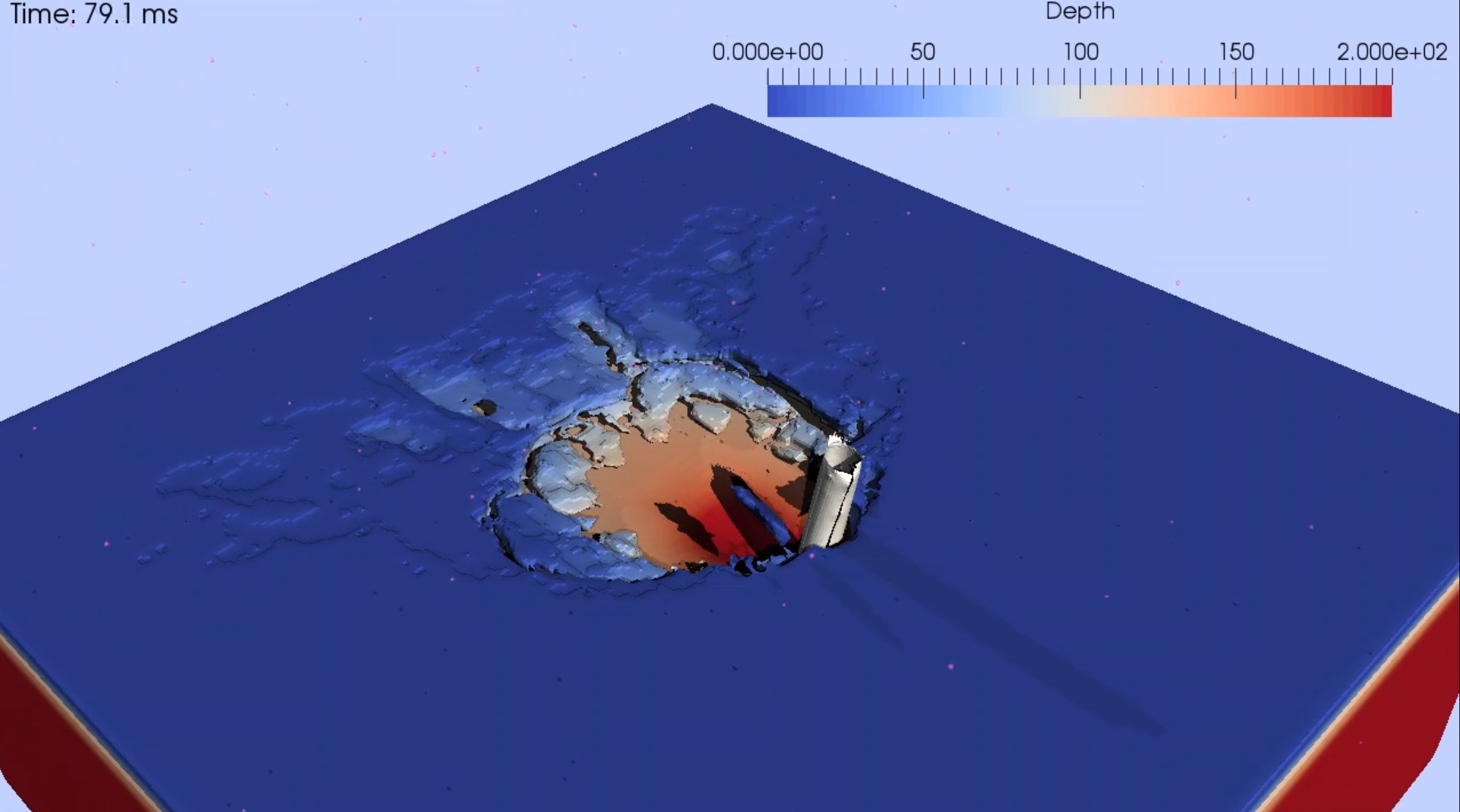
Screenshot from Postol et al’s simulation of the detonation of the simulated munition after it comes to rest (Source)
In multiple images and videos of this fragment, we can see that what Postol et al believe to be the external side of the rocket motor is covered with what appears to be some kind of textured layer. This layer evenly coats one side of the fragment.
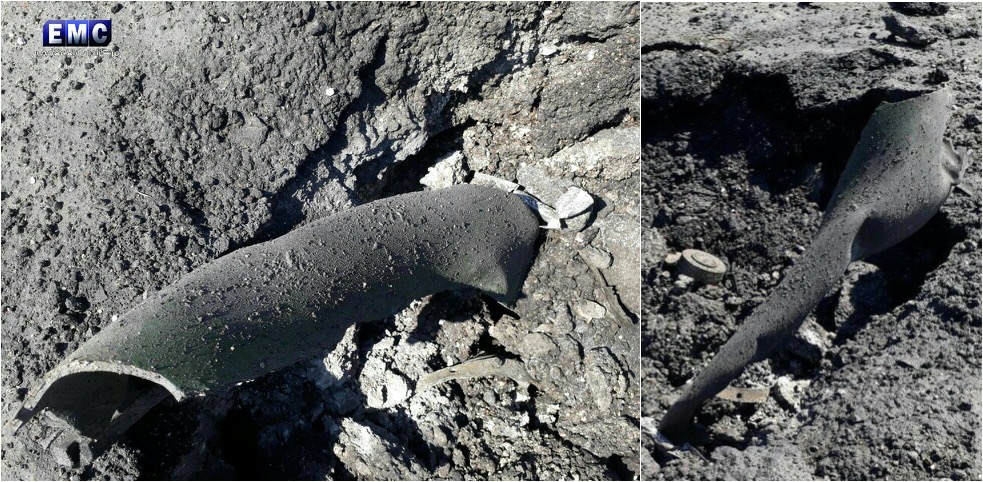
In these images the rough surface of the “rocket motor” is clearly evident (Source)
For anyone who has a basic understanding of how tube-launched artillery works, it is very clear that this coating makes this fragment very unsuited to being part of a rocket motor. This kind of coating would make it extremely difficult, if not impossible, to fit this “122 mm rocket motor” into a launch tube. It would also make it very inaccurate.
Postol et al also suggest that this “122 mm rocket motor” had a “weld” with a “strengthened edge”. Their simulation “assumes the preexistence of structural weakness along a generatrix of the cylinder, due to possible welding in the fabrication of a pipe”.
However, a closer examination of this “strengthened edge” does not appear to support the conclusion of Postol et al. Although said “edge” does appear to be a weld, after having modelled this fragment, we believe it is in fact part of the casing of a much larger munition.
Using a large number of images and videos of the fragment in the crater we have modelled what we believe this fragment could look like, both in its folded shape and once it has been unfolded.
One significant feature of the metal fragment is a curved metal bar attached to the fragment, which, according to Postol’s claim, must have run the length of the improvised rocket motor. The simulation does not appear to account for this feature, or how it would have been bent inwards by the detonation of a 122 mm warhead at the opposite end of the rocket motor. In Postol’s letter, published by Accuracy.org, Postol describes the metal fragment as follows:
“The OPCW report never identifies the metal “object” in the crater as a pipe of roughly 120 mm diameter. It instead describes the pipe as an object that the investigators assess was produced by the impact of a bomb of roughly 300 to 500 mm diameter. There is no explanation for how a sheet of metal could be rolled into a uniform diameter pipe of 122 mm diameter. The object that is a pipe is never described as pipe in the reports while the other object is identified in the report as a filler cap.”
It is difficult to understand how anyone who had taken the time to review the images of the metal fragment would come to the conclusion it was “a uniform diameter pipe of 122 mm diameter” as claimed by Postol. This claim simply doesn’t stand up to the most cursory examination of the images in question.
Inconsistencies between simulated and actual crater
Not only does the simulator crater not match any other 122 mm rocket craters we have observed, it doesn’t even match the crater seen at Khan Sheikhoun.
In Postol’s simulation, the rocket impacts a road where the tarmac is simulated as being 10 cm thick, with soil underneath. In the simulation we see that outside the bowl of the crater, the tarmac suffers extensive damage across a wide area. This damage is localised to the northern side of the crater bowl, and ranges from 1 cm to 10 cm in depth.
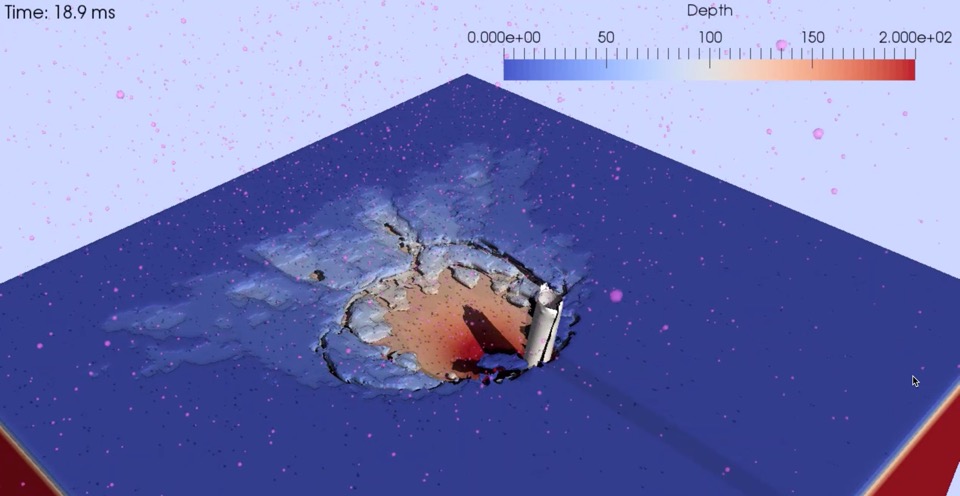
Damage seen in simulation. Note the extensive damage to the tarmac to the left (north) of the crater.
Nothing like this kind of damage is seen in the actual Khan Sheikhoun crater. The tarmac on the north side of the crater is almost completely undamaged, saved for several cracks. If the simulation was accurate, the area highlighted in yellow below would display significant damage, with lacerations going down at least 10 cm.
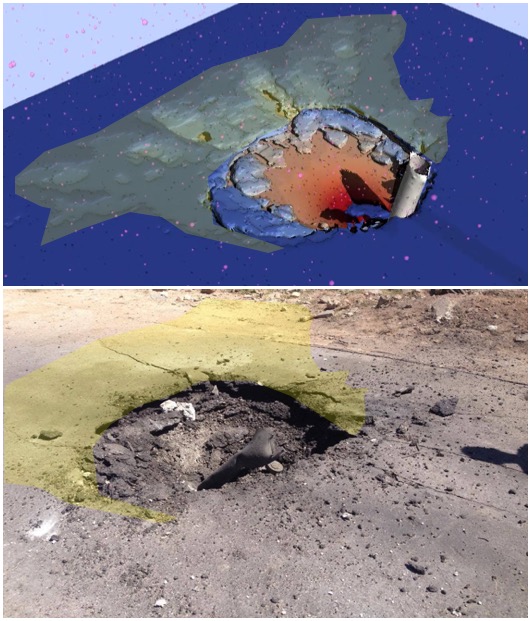
Comparison of damage seen in Postol’s simulation to actual crater (Source)
In fact, the kind of damage seen in the simulation is not seen in any direction around the crater.
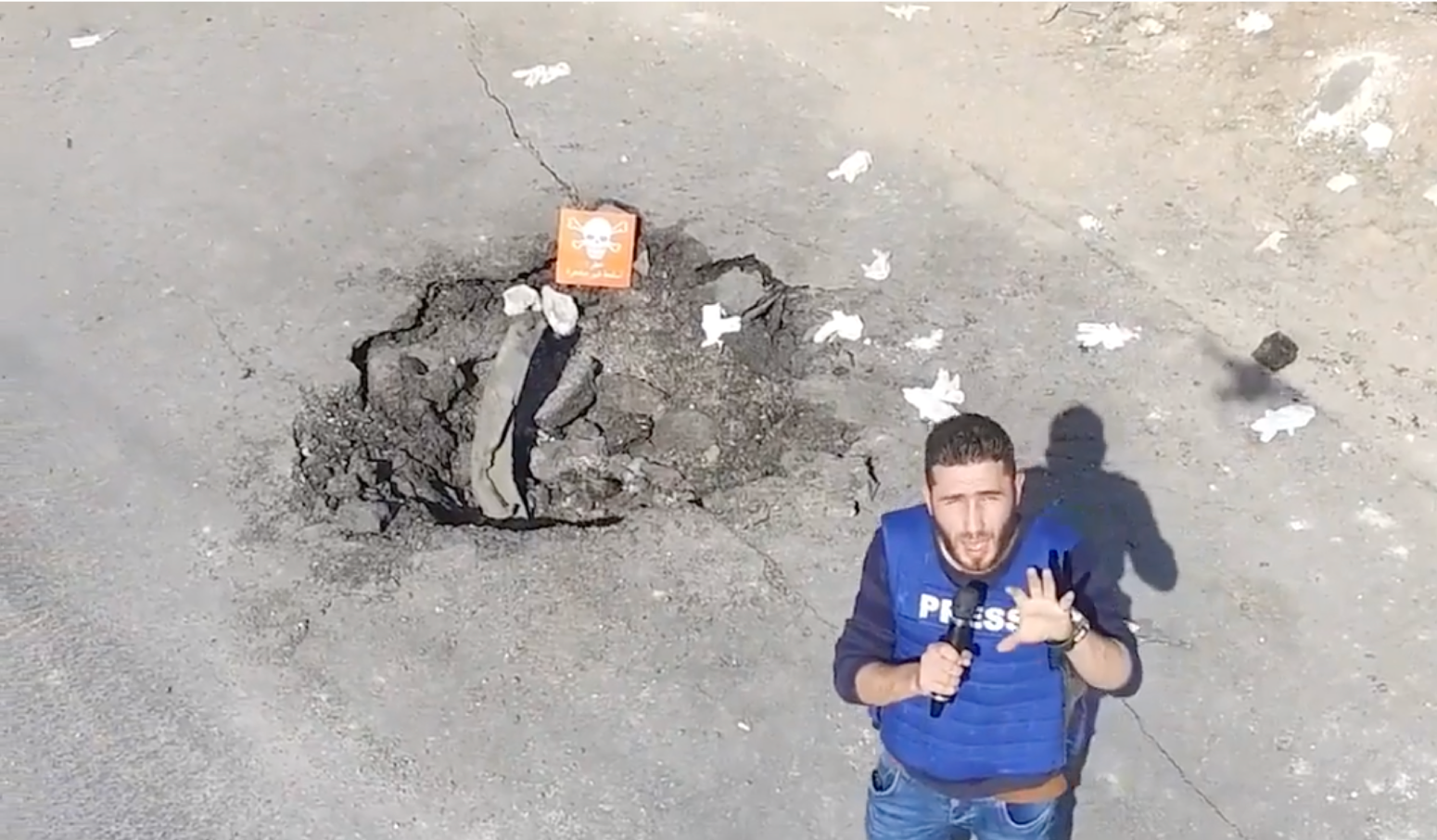
Note that no area around the crater displays anything like the level of damage seen in the simulation (Source)
This type of damage, which is part of the simulation, is consistent with other examples of 122 mm rocket impacts. During the detonation of the warhead shrapnel is blown outwards, and, when on flat surfaces, can leave a distinctive fan pattern.
This is something Postol should be well aware of. On May 22, 2019, Accuracy.org published New Assessments from Leading Scientist Accuse OPCW Leadership of Rigging on Alleged Syrian Chemical Weapons Attacks Used to Justify U.S. Bombings, based on letters and articles submitted by Postol to various bodies in relation to his report. In a covering letter, addressed to the “German Foreign Ministryl (sic)”, Postol reiterates his positions based on his latest analysis, including the following statement:
“The supercomputer calculations show that the geometry of the charge and its orientation relative to the ground produce a classic crater that has a tear-drop shaped perimeter (that is, a perimeter that is not circular). Craters with this shape are known to be produced by artillery rockets, as is documented in the UN manual for peacekeepers in the document, Introduction to UN Peacekeeping Pre Deployment Training Standards.
“Section 1.2, titled, Verification of Minefields, Explosive Remnants of war and Crater Analysis contains the basic information on crater recognition used by UN peacekeepers in the field. Similar discussions can be found in US Army Artillery Officer Field Manuals. These characteristics of artillery rocket craters are therefore very well known to true professionals who deal with these matters.”
The document he refers to includes diagrams of impact craters from various munitions. The following image shows the impact crater from a low angle fuze crater, created by munitions such as artillery shells and 122 mm rockets:
At Bellingcat, we are quite familiar with these craters and the measuring methods described in the UN Peacekeeping Pre Deployment Training Standards document. In 2015 and 2016, Bellingcat published two reports using a combination of satellite imagery showing crater impacts and the measuring methods described in the UN document to identify dozens of sites of cross border artillery attacks from the Russian Federation into Eastern Ukraine.
It is clear from the diagrams in the UN document that the craters described do not match the crater visible in Khan Sheikhoun, most notably for the lack of side spray from the detonation of the 122 mm warhead Postol et al have simulated.
In the video below, the simulation has been overlaid with an image of the real crater, showing where we would expect to see this damage:
The following comparison of the real crater and the simulated crater clearly shows the lack of damage in areas the Postol et al simulation indicates there should be damage — i.e. to the north of the crater:
Although the crater bowl is superficially similar in shape, the damage outside the bowl itself cannot simply be discounted, as it provides vital information about the nature of the munition and its direction of travel. It seems incredible that the authors of this paper could claim that “the computational mathematics and mechanics calculation essentially predicts most or all of the observed features of the crater at Khan Sheikhoun” because, as we see above, this is simply not true.
In the above video, it is notable that the warhead remains modelled in pink cross a space occupied by a metal cabinet. This is significant, because while Postol et al’s simulation shows this pink spray clearly damaging the floor around the crater, they have not modelled anything in the location of the metal utility cabinet.
Based on the simulation, it would appear there should be significant damage to this cabinet, but images from the scene show this is obviously not the case. The following video clearly shows no shrapnel damage is visible on the metal cabinet:
However, in the text of the report, Postol et al argues that this cabinet should be undamaged:
“Another argument made by the experts engaged by the JIM cites the scarcity of “visible signs of damage caused by fragmentation or overpressure, especially on the metal cabinet located 3 to 5 m away from the crater” [3, para 54]. Although it is not clear from the report, it appears that this observation applies to one of specific scenarios considered by the JIM, namely the one in which the crater was created by an explosive charge placed on the ground. In this scenario one indeed would expect to see a certain damage to the metal cabinet. However, in the scenario considered here, it should be taken into account that a cylindrical explosive charge, such as a 122-mm warhead considered in this analysis, would not produce a spherically-symmetrical blast wave or a debris cloud. For munitions with a high length-to-diameter ratio most debris would be distributed in an annular pattern that is perpendicular to the munition axis (pointed forward if the motion of the munition is taken into account). This effect, in fact, can be seen on the second panel of the explosion sequence shown on Figure 3.1. The location of the metal cabinet placed it in the solid angle that is unlikely to be affected by the explosion debris.”
At best, this demonstrates the simulation should have included some representation of the metal cabinet. This, combined with the lack of damage around the crater that’s present in the simulation, calls into question the accuracy of the claim made in the report that the simulation genuinely recreates the crater seen at Khan Sheikhoun, and certainly not as Postol claimed showing “exactly what is observed in the photograph.”
Problematic Methodology
Although Postol et al chose to simulate Postol’s previous, discarded theory, that a container of Sarin was blown open on the ground, they chose not to simulate a liquid-filled, air dropped munition. This is especially strange considering this hypothesis is the one proposed by the OPCW-UN JIM, regarded as the authority on the matter of chemical attacks.
Despite the wide and extensive range of evidence examined by the OPCW-UN JIM, the authors simply decided that they wouldn’t simulate it, a rather bizarre decision.
Publishing
Postol et al’s paper is written in an academic format as if it has been published in a journal, however we could not find any reference to it in any peer reviewed publication. The only sources for the paper appear to be Tulsi Gabbard’s website and Accuracy.org. According to Accuracy.org, “This manuscript has been accepted for publication by Science and Global Security, a refereed science-based journal published out of Princeton University.”
At the time of writing, the journal in question has not published this paper. We struggle to see how a peer reviewed journal could publish a document with so many grave and self evident errors, especially since said document already appears to have been used by a state party in an attempt to undermine the OPCW-UN JIM.
